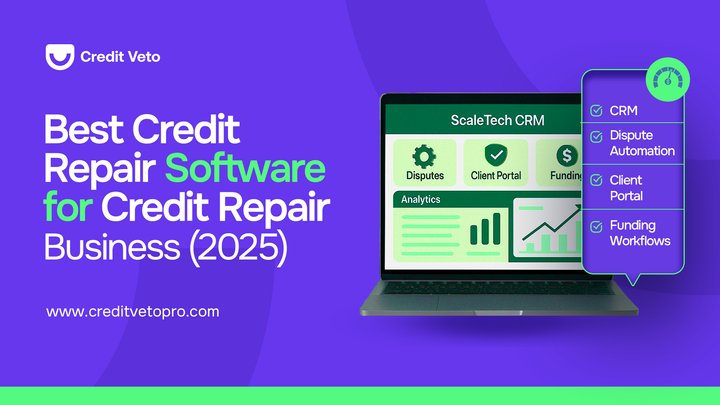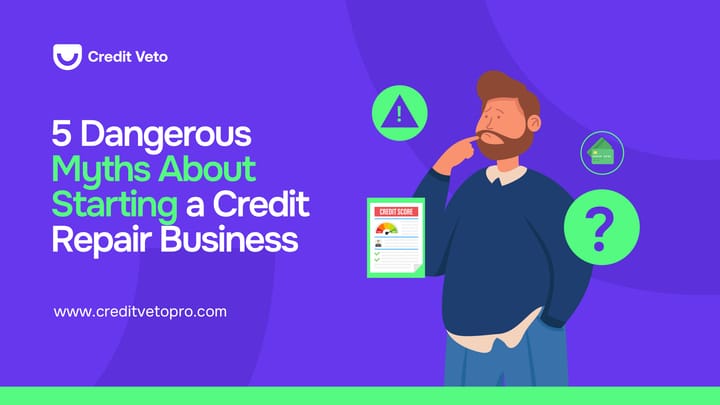Top 7 Steps to Launching Your Credit Repair Business with Zero Experience
Starting a credit repair business doesn't have to be overwhelming. With these top 7 steps, tools and free mentorship, you can quickly become an expert helping people improve their credit scores.

Like every other business, starting a credit repair business with no prior experience can seem daunting. After all, credit repair involves navigating complex laws, understanding credit reports, and knowing how to dispute negative items effectively. But what if you could skip the steep learning curve and hit the ground running?
The good news is that with the right tools and guidance, it’s entirely possible to build a successful credit repair business from scratch. This blog will walk you through everything you need to know, from setting up your business to getting your first clients, and will introduce you to a unique program that helps you gain practical experience.
By the end of this post, you’ll have a clear roadmap for launching your business and making your first steps toward success. Ready to move from bad credit to becoming a credit repair expert? Keep reading.
Why You Should Consider Starting a Credit Repair Business
Starting a credit repair business can be one of the most rewarding ventures, both financially and personally. With the increasing number of individuals seeking to improve their credit scores, the demand for professional credit repair services is at an all-time high. Here are some valid reasons why starting a credit repair business might be the perfect opportunity for you:
1. High Demand for Credit Repair Services
As the financial landscape continues to evolve, more people are finding themselves in need of credit repair services. With an increasing number of consumers struggling with credit-related issues, especially in uncertain economic times, there’s a growing need for credit repair specialists. If you’re ready to help people improve their financial futures, this industry offers plenty of opportunities.
2. Potential for High Earnings
Credit repair businesses have a relatively low startup cost compared to many other industries, and the potential for high returns is significant, with a market size value of US$ 7.04 billion in 2024. Also, with a pricing structure ranging from one-time fees to monthly retainers, you can build a profitable business while helping others restore their credit. Many credit repair businesses also experience steady income growth as they build a client base and reputation.
3. Helping Others Build a Better Financial Future
Credit repair is not just about numbers—it’s about changing lives. As a credit repair business owner, you’ll have the opportunity to help individuals secure better loan terms, qualify for mortgages, and improve their overall financial standing. By restoring people’s credit, you’re directly impacting their ability to achieve their financial goals, making the work meaningful and rewarding.
4. Low Overhead Costs
Unlike many businesses that require significant upfront investments in inventory or expensive equipment, a credit repair business has relatively low overhead costs. Your primary investments will be in tools like credit repair software and resources for client management, which are generally affordable and scalable as your business grows.
5. Flexibility and Scalability
The credit repair industry allows for great flexibility. You can run your business from home, build it around your schedule, and grow at your own pace. With tools from Credit Veto that automate many aspects of the business, you can scale quickly without significantly increasing your workload. This makes it an excellent option for entrepreneurs who value autonomy and work-life balance.
Breaking Down the Basics of Credit Repair
At its core, credit repair is the process of disputing errors, inaccuracies, and outdated information on your credit reports to improve their credit scores. Credit repair specialists work by identifying negative marks such as late payments, collections, or accounts that are inaccurately reported. After identifying these issues, the next step is to dispute them with the credit bureaus.
Here’s what you need to know before diving in:
- Credit Reports: Understand how to read and interpret credit reports. There are three major credit bureaus in the U.S.—Experian, Equifax, and TransUnion — and they provide a report containing details about an individual’s credit history.
- FICO® Scores: The FICO® score is the most commonly used credit score, and it’s crucial to understand how it’s calculated. It considers factors like payment history, amounts owed, length of credit history, new credit, and credit mix. Learning how each of these factors affects the score will help you guide your clients effectively.
- Disputing Errors: Understanding the process of disputing inaccuracies on credit reports is key to repairing credit. You’ll need to familiarize yourself with dispute letters, dispute templates, and how to handle responses from credit bureaus.
7 Key Steps to Starting Your Credit Repair Business with Zero Experience
Starting a credit repair business with no prior experience might seem overwhelming at first, but by following a clear, structured approach, you can set yourself up for success.
Here are seven crucial steps that will guide you through the process, from understanding the basics of credit repair to launching your business and attracting your first clients.
These steps will help you gain the knowledge, tools, and confidence needed to build a thriving credit repair business, even if you’re starting from scratch. Let’s dive in and get you on the path to success.
1. Understand the Credit Repair Industry
Before diving into the technical aspects of credit repair, it’s important to understand the credit repair industry as a whole. In 2025, credit repair is a growing field, especially as people continue to look for ways to improve their credit scores and financial health. As more people are looking for solutions, the need for credit repair specialists has never been higher.
2. Learn the Basics of Credit Scores and Reports
If you’re starting from scratch, you need to understand how credit works. The FICO® score (the most widely used credit score) and other credit scoring models like VantageScore play a significant role in the financial health of your clients.
Your potential clients are going to need help with understanding:
- Credit scores (FICO, VantageScore, etc.)
- Credit reports (what to look for, how to read them)
- How to fix mistakes on their reports
When you understand the basics of credit, you’ll have a solid foundation to help others. In fact, understanding credit repair laws (such as the Fair Credit Reporting Act and Credit Repair Organizations Act) is essential to protecting both your business and your clients.
For those new to credit repair, taking a step-by-step approach to mastering these basics is key to success. In fact, the 5×5 Credit Veto Challenge is designed to guide you through these crucial topics, step-by-step, with expert insights and practical tools.
3. Choose the Right Business Structure and Legal Compliance
Setting up a credit repair business requires more than just knowledge of credit — you also need to get the legal and business aspects in place. Choosing the right business structure (LLC, corporation, etc.) is important because it will affect your taxes, liabilities, and the level of protection your business has.
Additionally, you must ensure compliance with credit repair laws like the Credit Repair Organizations Act (CROA). This law regulates credit repair businesses and sets clear rules, such as prohibiting upfront fees until services are rendered and requiring written contracts.
Pro-Tip: Starting your credit repair business with the right legal foundation will save you headaches later.
4. Invest in the Right Tools and Software
In the digital age, having the right tools and software can streamline your business, automate tedious tasks, and help you focus on what matters: helping clients.
You’ll need:
- Credit repair software like Credit Veto which automates dispute letters and tracks client progress.
- CRM (Customer Relationship Management) software to manage client relationships.
- Billing and invoicing tools to ensure smooth transactions.
When you join the 5×5 Credit Veto Challenge, you’ll get access to tools like automated dispute letters and client management systems that will help you start on the right foot.
5. Understand How to Get Clients and Market Your Services
Getting clients for your credit repair business is crucial, especially when you’re just starting. Here are some tips on how to do that:
- Leverage social media: Create content on platforms like Facebook and Instagram. Offer free tips, educate your audience, and invite them to sign up for consultations.
- Networking: Partner with other professionals (e.g., mortgage brokers, car dealerships, real estate agents) who can refer clients to you.
- Client referrals: Word-of-mouth marketing works wonders in credit repair.
If you’re looking for faster results and automated client generation, the 5×5 Credit Veto Challenge offers real client matching, so you won’t have to worry about cold outreach.
6. Setting Your Pricing and Structuring Your Contracts
Pricing your services is one of the trickiest parts of running a credit repair business. You need to strike the right balance between offering value and ensuring you’re compensated for your efforts.
It’s crucial to:
- Set flat fees (based on services offered).
- Offer payment plans if necessary.
- Ensure that your contracts are clear and legally compliant with CROA.
In the 5×5 Credit Veto Challenge, you’ll get step-by-step instructions on structuring client contracts and setting pricing models that work for both you and your clients.
7. Grow Your Business and Scale
Once your credit repair business is off the ground, the next step is to scale. You can do this by:
- Hiring staff or virtual assistants to handle administrative tasks.
- Expanding your services (e.g., adding credit monitoring or credit education).
- Using automation tools to handle more clients without losing quality.
The 5×5 Credit Veto Challenge also guides scaling your business with advanced tools and resources that help you grow without the growing pains.
Learning Essential Terms and Tools
One of the quickest ways to start building credibility in the credit repair industry is by learning the key terminology and tools used by professionals. Here’s a breakdown of the most essential terms and tools to help you get started:
Key Terminology:
- Credit Utilization: The ratio of your credit card balances to your credit limit. It’s important for credit score calculation and can be a quick area to improve.
- Hard vs. Soft Inquiry: A hard inquiry occurs when a lender checks your credit report as part of a loan application, while a soft inquiry does not affect your score.
- Charge-Offs and Collections: Accounts that were once actively pursued for payment but have now been written off as a loss by creditors or sent to collection agencies.
- Late Payment and Delinquency: Overdue Payments can significantly damage a person’s credit score.
Key Tools:
- Credit Repair Software: Tools like Credit Veto are crucial in automating the dispute process, tracking progress, and organizing client data efficiently. As a beginner, choosing the right software will save you time and help you stay organized.
- CRM (Customer Relationship Management) System: CRM systems like HubSpot or Zoho help manage client communications, track progress, and send reminders for follow-ups.
- Payment Processing: You’ll need a reliable payment gateway for billing your clients, whether through Stripe, PayPal, or another service.
- Document Management Tools: Securely storing dispute letters, contracts, and client records is essential. Tools like Google Drive or Dropbox will help you organize documents and maintain secure storage.
- Books and Blogs: Start with books and blog posts that explain credit repair concepts. These resources will help you understand industry standards, and you can learn from successful credit repair specialists.
Learning Resources:
- Books and Blogs: Start with books and blog posts that explain credit repair concepts. These resources will help you understand industry standards, and you can learn from successful credit repair specialists.
- Online Courses and Certifications: Many credit repair experts offer free webinars, online courses, or certifications that will build your expertise and increase your credibility. In addition, the 5×5 Credit Veto Challenge provides a comprehensive, step-by-step training program tailored to beginners in the credit repair space.
How to Build Foundational Knowledge Before Taking on Clients
Before taking on your first client, it’s essential to have a solid foundation of knowledge. Here’s a roadmap for building that foundation:
Understand Credit Repair Laws:
- The Credit Repair Organizations Act (CROA) is crucial for ensuring your business is operating legally. Learn the basics of CROA to avoid common legal pitfalls, such as charging upfront fees or misleading clients with false promises.
- Learn how to properly manage client expectations. Your job isn’t to guarantee a specific increase in their score — you’ll be disputing inaccurate items and advising them on improving their credit habits.
Familiarize Yourself with the Dispute Process:
- Take the time to fully understand how the dispute process works. You need to know the steps to challenge inaccurate information, how long it typically takes, and the most effective way to dispute errors with credit bureaus.
- Learn about common disputes, such as medical collections, late payments, and charge-offs. These are the types of issues you’ll encounter most often.
Practice Using Credit Repair Tools:
- Start familiarizing yourself with the tools you’ll be using to repair credit. Credit Veto offers a comprehensive dashboard for managing disputes and client relationships. Using these tools will help you save time and stay organized.
- Get hands-on experience by practicing with sample credit reports and dispute letters, so you’re comfortable with the system before handling real clients.
Study Successful Credit Repair Businesses:
- It’s also helpful to look at what successful credit repair businesses are doing. Find mentors, read success stories, or even reach out to industry professionals to get guidance and tips.
- Joining programs like the 5×5 Credit Veto Challenge can give you access to a community of experts who can provide advice and insights as you get started.
Conclusion
Starting a credit repair business from scratch doesn’t have to be overwhelming. By focusing on the basics — understanding credit reports, learning essential tools, and practicing the dispute process, you can build a successful credit repair business even with no prior experience.
Mentorship Matters: The 5×5 Credit Veto Challenge is designed to give you hands-on experience and help you gain the knowledge and confidence to hit the ground running. With expert mentorship, practical tools, and a proven step-by-step training process, you’ll be well on your way to starting a successful credit repair business.
By following these foundational steps and continually learning, you’ll be able to build a credible and successful business that helps people improve their credit and their lives. Sign up for the 5×5 Credit Veto Challenge today and fast-track your way to becoming a certified credit repair professional.




Comments ()